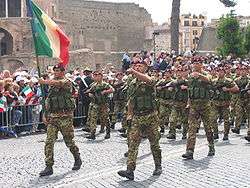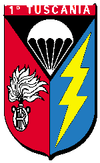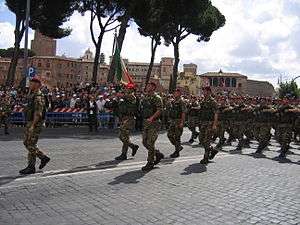1st Carabinieri Paratroopers Regiment "Tuscania"
The 1st Carabinieri Paratroopers Regiment "Tuscania" (Italian: 1° Reggimento Carabinieri Paracadutisti "Tuscania") is a special operations unit[1] of the Italian Carabinieri. It forms with the 7th Carabinieri Regiment in Laives, the 13th Carabinieri Regiment in Gorizia, and the Special Intervention Group the 2nd Carabinieri Mobile Brigade. The regiment is based in Livorno, and has approximately 550 personnel.[1] [4]
| 1st Carabinieri Paratroopers Regiment "Tuscania" | |
|---|---|
| 1° Reggimento Carabinieri Paracadutisti "Tuscania" | |
 Paratroopers of the regiment parade in Rome in 2006 | |
| Active | 1940-1942 1963-present |
| Country | |
| Branch | |
| Type | Paratroopers |
| Role | Special operations, diplomatic protection |
| Size | Regiment 550 |
| Part of | 2nd Carabinieri Mobile Brigade |
| Garrison/HQ | "Vannucci" Barracks, Livorno, Italy |
| Nickname(s) | "I Leoni del Deserto"[1] (Desert Lions) |
| Motto(s) | "Se il destino è contro di noi, peggio per lui." (If Destiny is against us, too bad for him.) |
| Engagements | Lebanon, Namibia, Somalia, West Bank, Bosnia, Kosovo, Afghanistan, Iraq |
| Decorations | |
| Commanders | |
| Commander | Col. Francesco Marra[4] |
| Insignia | |
| Breast insignia |  |
History
The history of Carabinieri Paratroopers dates back to World War II. On 5 June 1940, the Chief of Staff of the Italian Royal Army, then Army General Mario Roatta, requested the Commandant General of the Royal Carabinieri, at the time Lieutenant General Riccardo Moizo, to establish a Royal Carabinieri Paratroopers Battalion, approving an earlier request of General Moizo.[6]p.24
On 1 July 1940 the 1st Royal Carabinieri Paratroopers Battalion (1° Battaglione Reali Carabinieri Paracadutisti) was established with three companies in Tarquinia. On 9 July, Undersecretary Army General Ubaldo Soddu objected to the establishment of a Carabinieri battalion, arguing that a single-arm of single-speciality battalion could not be established (also in order to avoid rivalries); under the terms of Soddu's report, the Royal Carabinieri could establish only platoon-level units. The Higher Air Force Command, nonetheless, kept the Carabinieri Battalion in force.[6]p.27 The following year the unit was framed within the 1st Paratroopers Regiment.[7]
The first commander was Major Bruto Bixio Bersanetti; on 28 August 1940 he was replaced by Major Edoardo Alessi.[8]pp. 95–96
When deployed in Libya, the Battalion consisted of:[8]p.99
- Command unit: led by Lieutenant Max Ambrosi;
- 1st Company: led by Lieutenant Gennaro Piccinini Leopardi;
- 2nd Company: led by Lieutenant Giuseppe Casini;
- 3rd Company: led by Lieutenant Osmano Bonapace;
- Engineers-Saboteurs Platoon: led by Lieutenant Renato Mattei.
For a total of 26 officers, 51 non-commissioned officers and 322 troops.
The battalion performed counter-commando activity in Libya (a platoon)[8]pp. 100–102 and fiercely fought in Eluet el Asel area in December 1941[9] and in Ajdabiya as a company (under Lieutenant Osmano Bonapace),[8]pp. 128–129 being disbanded in 1942 in Castelvetrano.[10]
With the surviving personnel, two Carabinieri Sections were formed: the 184th Carabinieri Section was assigned to the Folgore Division, while the 314th Carabinieri Section was assigned to the Nembo Division and fought in the Italian Civil War on the loyalist side.[10]
After the end of the war, the Carabinieri did not immediately re-establish a paratroopers unit. However, on 15 May 1951 the Army, on the basis of a specific Carabinieri proposal, formed a Parachute Carabinieri Unit in Viterbo, under the direct authority of the General Command,[7] for riot emergencies.[11] The Unit was devoted to the fullfilment of the Carabinieri gendarmerie tasks and was 140 troops-strong.[12]
On 10 January 1956, the Parachute Carabinieri Unit participated in the rescue operations for Viterbo and its surroundings, whose inhabitants had remained isolated, without food and without medical assistance, due to the violent blizzards that had paralyzed the road network and communications in that province.[12]
In 1958 the unit was transferred to Livorno ("Vannucci" Barracks) and then to Pisa, the same city as the Parachute School, until 1962, when it was moved back in Livorno.[7]
Paratroopers Brigade Folgore
On 1 January 1963, within the general Army reorganization, the Paratroopers Brigade Folgore was formally established; the Parachute Carabinieri Unit was renamed Parachute Carabinieri Company. In the same year the company was expanded and reorganized as Parachute Carabinieri Battalion "Tuscania" within the Folgore Brigade; in 1975 the battalion was renamed I Parachute Carabinieri Battalion "Tuscania".[7] Elements of the Parachute Carabinieri Battalion "Tuscania" served in Alto Adige in 1960s against South Tyrolean terrorism,[13][14]p. 20 within the 150-troops strong Special Antiterrorism Company, along with Paratrooper Saboteurs (predecessors of present-day Italian special forces), Alpine, Guard of Finance and police troops. The Special Antiterrorism Company was led by Paratrooper Carabinieri Captain Francesco Gentile, dead in the 1967 Cima Vallona attack.[4]
The battalion was officially recognized as the legitimate heir of the 1st Parachute Royal Carabinieri Battalion in 1976, when its War Flag was awarded with the Silver Medal for Military Valour for the North African campaign.[7] In the same year, the Parachutism Section of the Carabinieri Sports Centre was established within the battalion.[15]
In 1978, the Special Intervention Group was established as a counter-terrorist unit; the personnel were selected from the ranks of the battalion.[15] From 1982 to 1984 the 1st Parachute Carabinieri Battalion was part of UNIFIL with the task of providing protection to Sabra, Chatila and Burj el-Barajneh refugee camps.[15] From 1991 to 1994 the battalion was part of UNITAF and in UNOSOM II missions in Somalia, where it was involved in several combat situations.
The current designation of Regiment was awarded on 1 June 1996,[15][12] when a third operational Company was added.[4] In 2000, the Regiment deployed fifty paratroopers in Naples in the Operation "Golfo".[16]
2nd Carabinieri Mobile Brigade
The regiment has been subordinated to the 2nd Carabinieri Mobile Brigade since 15 March 2002,[17]p. 184 having been moved from Folgore Parachute Brigade.[18] Despite the status of an Armed Force being awarded to the Carabinieri on 5 October 2000, the "Tuscania" shares the maroon beret of the paracadutisti.[1]
According to Major General Nicola Zanelli, Commander of the CO.F.S. (the Italian joint Command of special forces), in 2017 a company of the 1st Paratroopers Carabinieri Regiment "Tuscania" is intended to be upgraded to the special forces (Tier 2) level.[19] As of 2018, some military expert call for the establishment of an additional operational Company or even of an additional Battalion.[4]
Missions and operations

The unit has been involved in all major operations abroad of the Italian Armed Forces:[18]
- Namibia (1989-1990), UNTAG;
- Kurdistan (1991), AIRONE 1;
- Turkey (1991), AIRONE 2;
- Somalia (1992-1994), IBIS (covering UN-sanctioned mission UNITAF): military police and rapid reaction unit;[12]
- Cambodia (1992), UNTAC;
- Somalia (1993), UNOSOM II;
- Israel (2 May 1994 - 8 August 1994),[12] TIPH 1;
- Bosnia and Herzegovina (1996-2003), IFOR/SFOR;
- Palestinian territories (27 January 1996 - 25 July 1996),[12] TIPH 2;
- Albania (1997-1999), Operation Alba: military police services, coordination of military police entities of all other contingents, escort of the mission commander, of the International Commission, of VIPs and journalists, human intelligence, high-risk interventions, liaison with local authorities and Albanian Police, territory surveillance;[12]
- East Timor (1999-2000), United Nations Mission in East Timor;
- Kosovo (2000-2003), Kosovo Force;
- Republic of Macedonia (2001-2002), AMBER FOX;
- Afghanistan (since 2001), ISAF;
- Iraq (since 2003), MSU, Prima Parthica;[14]p. 21
- Gaza Strip (2005-2009), EUBAM RAFAH;
- Palestinian territories (Jericho, March–July 2014), MIADIT PALESTINA;
- Libya (Tripoli, March–July 2014), MMIL.
Mission
Missions entrusted to the Regiment are of three broad types:[18]
- Military duties (typical of paratroopers):[4]
- Police duties:
- Support to territorial units of the Carabinieri;
- Riot control (particularly difficult or complex situations);[14]p. 23
- Security at diplomatic missions in "at risk" countries;
- VIP escort;
- Training: training and education of Carabinieri of special units.
The Carabinieri Regiment "Tuscania" is a Crowning units for special operations (Italian: Unità di coronamento per le operazioni speciali), i.e. is tasked with protection and belting of special forces, mainly the Special Intervention Group, as well as operational support to Special Forces units.[1]
All members of the Special Intervention Group come from the ranks of the Regiment.
Support to territorial units
The Tuscania Regiment can assist the territorial units of the Carabinieri in the control and surveillance of mountainous or otherwise impervious terrain and the search for dangerous fugitives (alongside the specialized Cacciatori units).[4]
Counter-terrorism
In order to cope with counter-terrorism needs, in 2016 the Special Intervention Group and the Tuscania Regiment formed two Counter-terrorism Task Units (Task Unit Anti Terrorismo, T.U.A.T.)[4] in Central and Northern Italy in order to allow G.I.S. to carry out hostage rescue and urban warfare while being protected by the "Tuscania" units.[14]p. 4
The counter-terrorist task units are deployed in sensitive locations and on special occasions; these units are designed in order to be able to fight in urban warfare and terrorist attack scenarios, as well as hostage rescue.[4]
Recruitment and training
Those aspiring to the Regiment, of all ranks, are first submitted to a psycho-physical selection, aimed at ascertaining their attitude to the specific employment; then they are admitted to taking a training course lasting 44 weeks, including:[18]
- Parachuting course;
- Patrol and platoon-level training (guerilla warfare and counter-insurgency);
- Training to the use of special weapons and materials.
Only one candidate out of four attains the rank of Explorer Paratrooper, but the training does not end then. After passing the final test of the course, the paratrooper Carabiniere passes in the Battalion, in which performs operational, maintenance training and further specialization activities. In particular, the Paratrooper Carabiniere specializes in:[18]
Organization
The Regiment consists of:[18]
- Command Office: Commander support;
- Training Unit;
- Command and Services Company: logistics support;
- Parachute Carabinieri Battalion "Eluet el Asel":[20]
The Regiment also has a Sport Parachute Section, which is placed directly under the General Command of the Carabinieri.[22]
Regimental Command
The Regiment Command has the traditional subdivisions of the Personnel, Operations Training Information, Logistics, Administrations and Health Sections; the Command controls the Training Unit, the Supports Unit and the Paratrooper Carabinieri Battalion. All Regiment personnel is considered capable to be deployed on operations and all personnel is sent on mission on rotational basis.[4] The Training Unit, led by a field officer, provides recruitment, selection and training of the personnel of all ranks. This ensures a standard training.[4]
Battalion
The Battalion "Eluet el Asel" (named after the battle of Eluet el Asel where the 1st Royal Carabinieri Paratroopers Battalion fought with distinction)[8]pp. 100–102 is the operational element of the whole Regiment, and it consists of a Battalion Command and of three operational Paratrooper Carabinieri Companies. The Battalion Command has a limited operational capability to make tactical plans, with a Tactical Command and Pianification Squad, a Specialist Training Squad and of a Proximity Support Section (in charge of weapons and vehicles).[4]
There are also three operational Paratrooper Carabinieri Companies. Each Company has three Platoons specialized in three different combat environments: amphibious warfare, mountain warfare or military free fall launch techniques.[4] Each of the three Paratrooper Carabinieri Companies include a command element and three Platoons, in turn consisting of 8 Teams of 4 Troops each; the organization is designed in order to operate in urban warfare scenarios and to be transported on a Lince vehicle. Each Team is led by a non commissioned officer, while a Team in each Platoon is led by the Platoon leader, usually a Lieutenant or an expert Marshal. Each Platoon also has specialized troops, organically part of the various Teams: Joint terminal attack controllers, EOD experts, laser-guidance operators, snipers and military rescuers.[4]
Individual armament
Apart from special allocations of certain operators (see, for example Barrett M82), possibly related to the use of squad weapons or to the needs of unconventional warfare, any Tuscania member carries the same sidearm as common Carabinieri, the Beretta 92FS, and, like most Italian paratroopers, the foldingstock SC 70/90 or the shortened SCS 70/90 version of the Beretta AR70/90 assault rifle, M4 Bushmaster assault rifle,[21] or Beretta Model 12 sub-machine gun currently provided to the Italian armed forces. By the late 1990s, the Beretta rifle has been replaced by a version of the American carbine M4A1 built by Bushmaster and equipment vests are a special version of the Israeli "Ephod" made for the Tuscania regiment by an Israeli firm, Hagor. They also use the HK53 with a British-made 40mm grenade launcher.
Sports
Regiment "Tuscania" also includes a Sport Parachute Unit, which boasts many excellent results, both in the civil and military spheres, including several world titles achieved in the years 1990, 1994, 1998, 1999.
See also
- Gendarmerie
- Italian special forces
- Paratroopers Brigade Folgore
Notes and references
- Ranaldo, Giovanna (27 March 2015). "I CARABINIERI PARACADUTISTI, GLI EREDI DI UNA GRANDE STORIA". DeArmas (in Italian). Retrieved 17 March 2017.
- "Ricompense". www.carabinieriparacadutisti.it (in Italian). Retrieved 17 March 2017.
- Segretariato generale della Presidenza della Repubblica-Servizio sistemi informatici-. "Bandiera Del 1° Battaglione Carabinieri Paracadutisti "Tuscania"". Quirinale. Retrieved 17 March 2017.
- Scarpitta, Alberto (7 August 2018). "Il 1° Reggimento Carabinieri Paracadutisti "Tuscania" – Analisi Difesa". Analisi Difesa (in Italian). Retrieved 8 August 2018.
- "Distintivi di reparto ed enti vari 2". www.carabinieri.it (in Italian). Retrieved 11 July 2017.
- Cursi, Enrico (2016). "Retroscena della nascita dei Carabinieri paracadutisti" (PDF). Notiziario Storico dell'Arma dei Carabinieri. 1 (3): 24–25, 27. Retrieved 14 May 2018.
- "Paracadutisti". www.carabinieri.it (in Italian). Retrieved 16 March 2017.
- Arena, Nino (1966). Folgore - Storia del paracadutismo militare italiano (in Italian). Rome: Centro editoriale nazionale divulgazioni umanistiche sociologiche storiche. pp. 95–96, 99, 100–102, 128–129.
- "Eluet el Asel Lamluda". www.carabinieri.it (in Italian). Retrieved 16 March 2017.
- "La guerra". Carabinieri Paracadutisti. Retrieved 16 March 2017.
- VV, AA (2014). Forze Speciali Italiane (in Italian). Edizioni R.E.I. p. 318. ISBN 9782372970594. Retrieved 17 March 2017.
- Tatarelli, Luca (5 June 2020). "SPECIALE FESTA ARMA DEI CARABINIERI: Paracadutisti "Tuscania", 80 anni di storia in Patria e all'estero". Report Difesa (in Italian). Retrieved 6 June 2020.
- "Il Battaglione". Carabinieri Paracadutisti. Retrieved 16 March 2017.
- "Il dispositivo antiterrorismo dell'Arma dei Carabinieri alla luce delle nuove minacce internazionali" (PDF). www.carabinieri.it (in Italian). pp. 4, 17, 20–24. Retrieved 17 March 2017.
- "Il Tuscania". www.carabinieriparacadutisti.it (in Italian). Retrieved 16 March 2017.
- Marino, Giovanni (18 September 2000). "I parà per rastrellare i rioni - la Repubblica.it". Archivio - la Repubblica.it (in Italian). Retrieved 18 June 2018.
- Sinossi di storia dell'Arma (PDF) (in Italian). Redazione della “Rassegna dell’Arma dei Carabinieri”. 2016. Retrieved 16 July 2017.
- "Rgt.CC Par. Tuscania". www.carabinieri.it (in Italian). Retrieved 17 March 2017.
- Vespa, Stefano (23 July 2017). "Segretezza, pericolo, tecnologia: intervista al comandante delle Forze speciali, Zanelli - Formiche.net". Formiche.net (in Italian). Retrieved 14 August 2017.
- "Carabinieri". Comandante Ramius - Appunti di Storia militare. Retrieved 28 March 2017.
- Federici, Giusy (22 June 2017). "Tuscania: l'Arma perfetta (1 parte)". Difesa Online (in Italian). Retrieved 22 June 2017.
- Magazine Il Carabiniere, November 2006
External links
- Special/unit+Mobili/06_Tuscania.htm www.carabinieri.it
- the official website of the Italian Army Individual Weapons of the Italian Army
- unofficial site